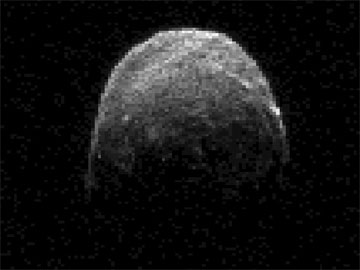
Asteroid's Close earth flyby 2:28 pm Ketchikan time
November 08, 2011
Tracking of this aircraft carrier-sized asteroid began at 8:30 a.m. local time (AST) on Nov. 4, using the massive 70-meter (230-foot) Deep Space Network antenna, and last for about two hours. The asteroid will continue to be tracked by Goldstone for at least four hours each day from Nov. 6 through Nov. 10. Radar observations from the Arecibo Planetary Radar Facility in Puerto Rico will begin on Nov. 8, the same day the asteroid will make its closest approach to Earth at 2:28 p.m. Ketchikan time (AST).
The image was taken on Nov. 7 at 10:45 a.m. Alaska Standard Time (AST), when the asteroid was approximately 860,000 miles (1.38 million kilometers) away from Earth. Tracking of the aircraft carrier-sized asteroid began at Goldstone at 9:30 a.m. PDT on Nov. 4 with the 230-foot-wide (70-meter) antenna and lasted about two hours, with an additional four hours of tracking planned each day from Nov. 6 - 10. The trajectory of asteroid 2005 YU55 is well understood by NASA. At the point of closest approach, it will be no closer than 201,700 miles (324,600 kilometers) as measured from the center of Earth, or about 0.85 times the distance from the moon to Earth. The gravitational influence of the asteroid will have no detectable effect on Earth, including tides and tectonic plates. Although the asteroid is in an orbit that regularly brings it to the vicinity of Earth, Venus and Mars, the 2011 encounter with Earth is the closest it has come for at least the last 200 years. The Near-Earth Object Observations Program at the Jet Propulsion Laboratory (JPL) in Pasadena, Calif., commonly called "Spaceguard," discovers these objects, characterizes some of them, and plots their orbits to determine if any could be potentially hazardous to our planet. JPL manages the Near-Earth Object Program Office for NASA's Science Mission Directorate in Washington.
Edited by Mary Kauffman, SitNews Source of News, Video, & Photo:
E-mail your news &
photos to editor@sitnews.us
|
|||
